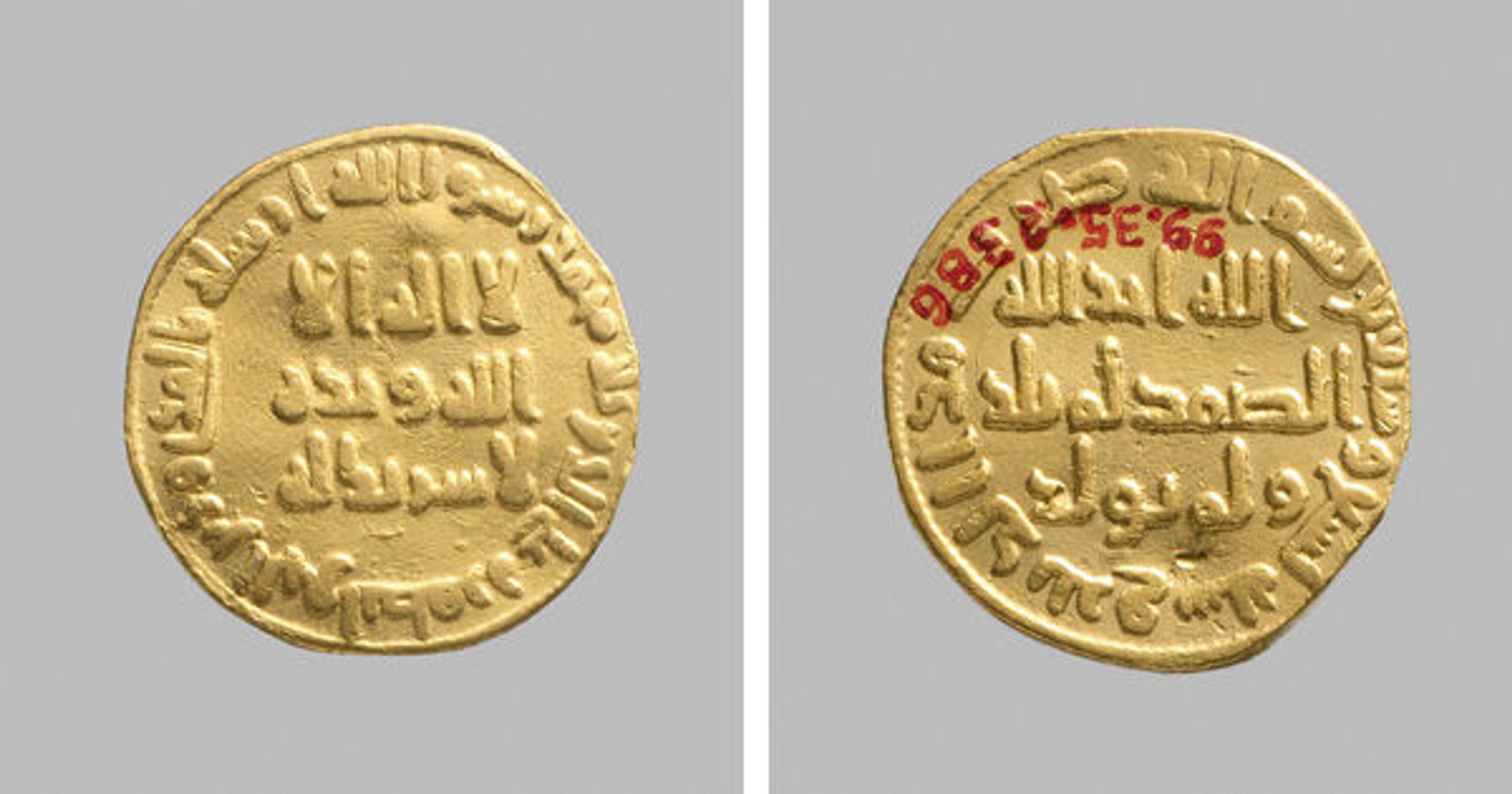The Globe-trotting Coin

Coin, dated A.H. 79/A.D. 698–99. Syria. Islamic. Gold; Diam. 13/16 in. (2.1 cm). The Metropolitan Museum of Art, New York, Bequest of Joseph H. Durkee, 1898 (99.35.2386)
«Coins are usually bestowed with a lot of nuisance value. Think of all those copper pennies collecting at the bottoms of our purses and pockets, adding weight to our wallets and being collected in fountains all over New York City! We don't usually think of the great travel capability of coins, yet as some of the smallest portable objects produced by humankind, they quietly traverse the globe every day on planes, trains, and automobiles.»
This transportability is no longer terribly useful, with today's limitations on what currency is accepted where. In the past, however, coin value was based primarily on its metal content and not limited to national or economic boundaries. The gold solidus introduced by the Byzantines, for instance, had a high standard of purity and continued to circulate in Syria and Palestine after the Arab conquest. This fact speaks to the incredible power and reach that currency once had, ultimately spanning across vast geographies and chronologies.
Mints were not simply stamping out plain gold, silver, and copper coins; careful thought went into the designs of coinage, due to their representation as the identity of a particular empire or dynasty. And why wouldn't they? Coins are arguably a mobile, public art. The Met has some wonderful examples of coins in the collection of the Department of Islamic Art that illustrate the ways in which different dynasties and emperors have represented themselves.
Minted in A.H. 79/A.D. 698–99, during the rule of the Umayyad 'Abd al-Malik (r. 685–705), the coin shown above was designed entirely free of figural representation. The obverse side contains the beginning of the Muslim declaration of faith (shahada) in the center ("There is no God but God alone"), while the central text on the reverse contains an excerpt from the Qur'an. A few years prior to the minting of this coin, 'Abd al-Malik had instituted a series of administrative reforms that included making Arabic the official governing language of the Umayyad Empire. The coins, which had previously featured variant features of Byzantine and Sasanian coins, effectively demonstrated the reform and the new identity being espoused by the Arabs, one which carried overt Islamic messages.

Dirham of Ghiyath al-Din Kai Khusrau II (r. 1237–46), dated A.H. 641/A.D. 1243. Turkey, Konya. Islamic. Silver; Diam. 7/8 in. (2.2 cm). The Metropolitan Museum of Art, New York, Bequest of Joseph H. Durkee, 1898 (99.35.2392)
This silver coin was minted in Konya, Turkey, in A.H. 641/A.D. 1243, during the reign of the Rum Seljuq sultan Ghiyath al-Din Kai Khusrau II (r. 1237–46), whose name and title feature prominently on the reverse side of the coin. On the obverse is a central image of a sun face underneath which a striding lion is depicted, as well as the name of the Abbasid caliph to whom the Rum Seljuqs pledged allegiance. A number of interpretations are possible for the imagery on Kai Khusrau II's coin, but I think at a very basic level it is an image of strength. The sultan was particularly fond of the sun-lion motif, and it was minted for several years. It is particularly interesting that in the last years of his reign, the coin design was transformed to a nonfigural one that included the shahada prominently on one side. This change to a more "Islamic" coin indicates the awareness of the sultan that coins carried important messages about the character of the empire.

Coin, dated A.H. 1031/A.D. 1621–22. India, Agra. Islamic. Gold; Diam. 13/16 in. (2.1 cm), W. 1/16 in. (0.2 cm). The Metropolitan Museum of Art, New York, Bequest of Joseph H. Durkee, 1898 (99.35.7401)
This Mughal coin, minted during the reign of Jahangir (r. 1605–27) in A.H. 1031/A.D. 1621–22, is one of a group of coins representing signs of the zodiac. In his memoirs, Jahangir recounts his decision to have coins minted with these astrological signs:
Prior to this, it has been the rule that on one side of gold coins my name has been engraved, and on the other side the name of the minting place, the month, and the regnal year. Around this time it occurred to me that instead of the month a figure of the constellation representing the month should be depicted . . . for every month in which a coin is minted one side would bear a picture of the constellation in which the sun rose. This method is peculiarly my own and has never been used before.1
This extraordinary account tells us of the personal interest the Mughal emperor took in designing coins and in claiming it as a unique idea. It's also worth noting that Jahangir was superstitious and paid very careful attention to horoscopes and astrology, and his memoirs are full of references to auspicious events.
Three very different coins and three very different strategies of display. I invite your thoughts and further interpretations in the comments below.
[1] Wheeler M. Thackston, ed., trans., The Jahangirnama: Memoirs of Jahangir, Emperor of India (New York: Oxford University Press, 1999), 260.
Fatima Quraishi
Fatima Quraishi is the 2014–15 Hagop Kevorkian Fellow in the Department of Islamic Art.